
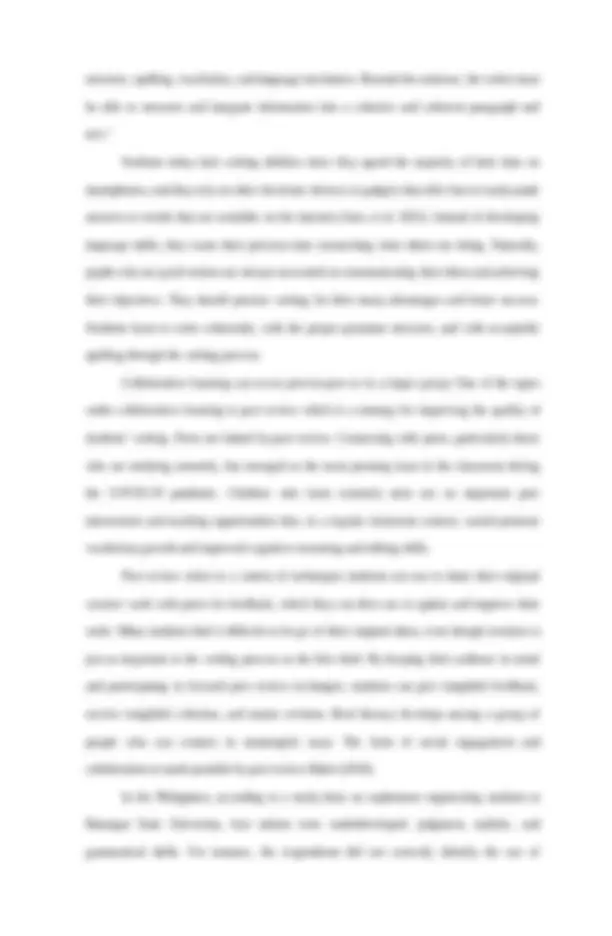
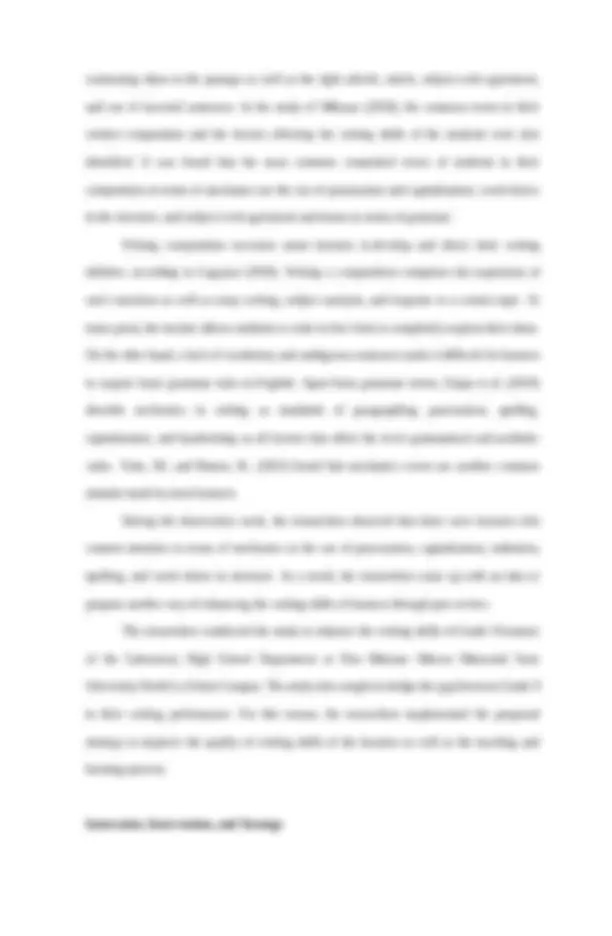
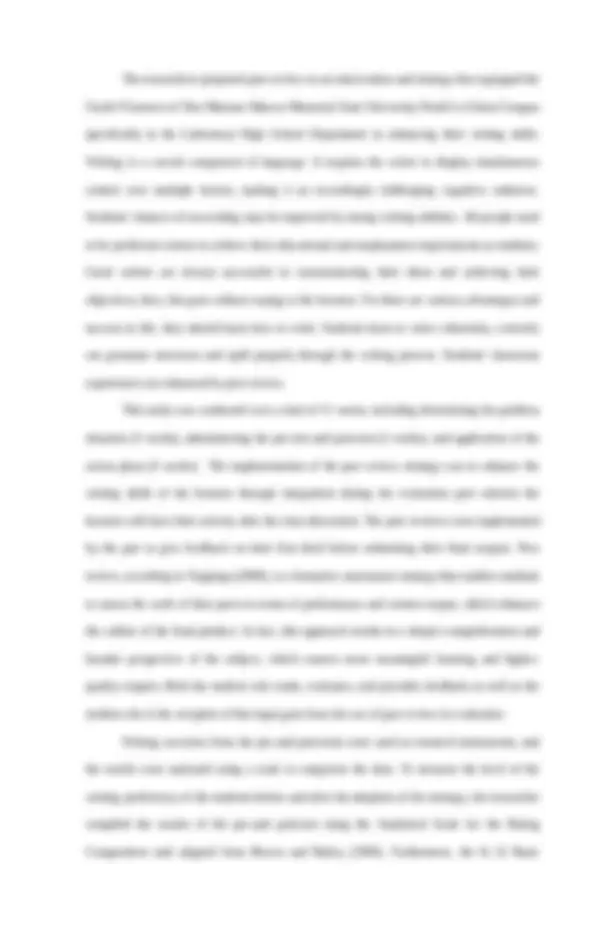
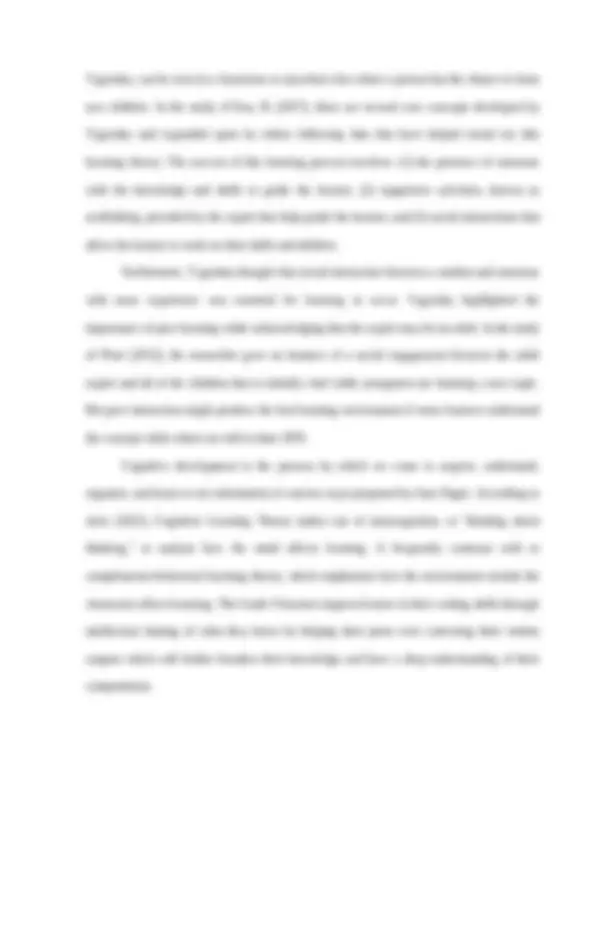
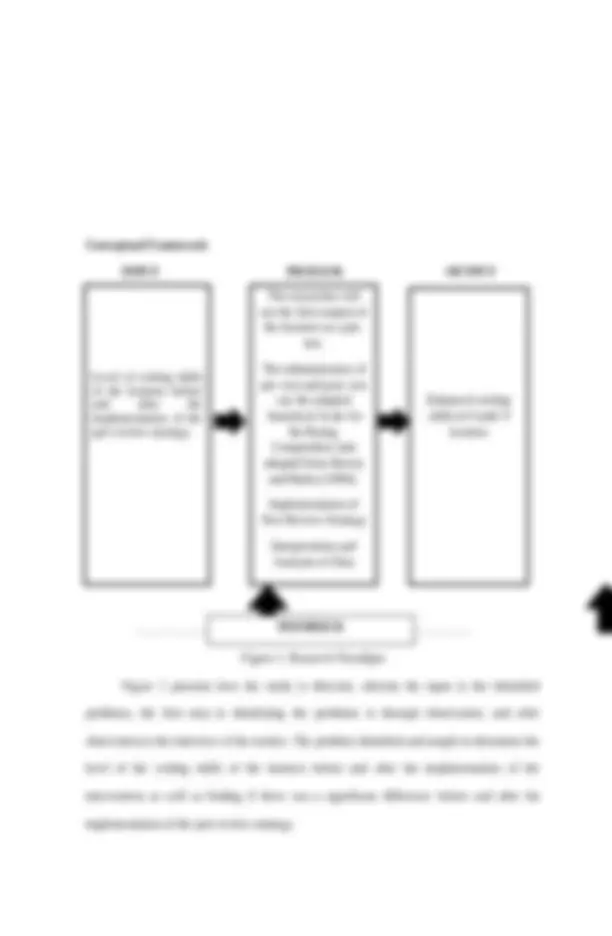
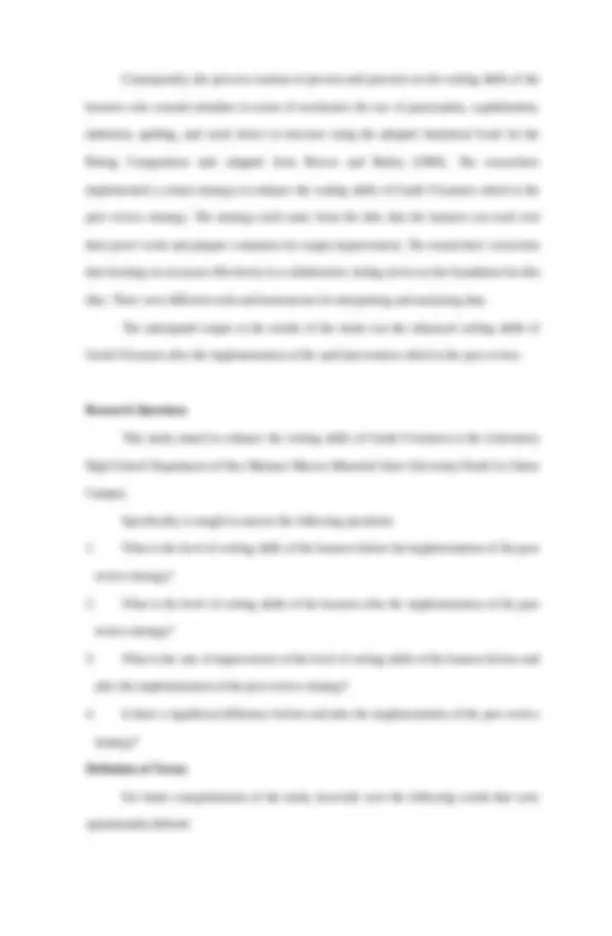
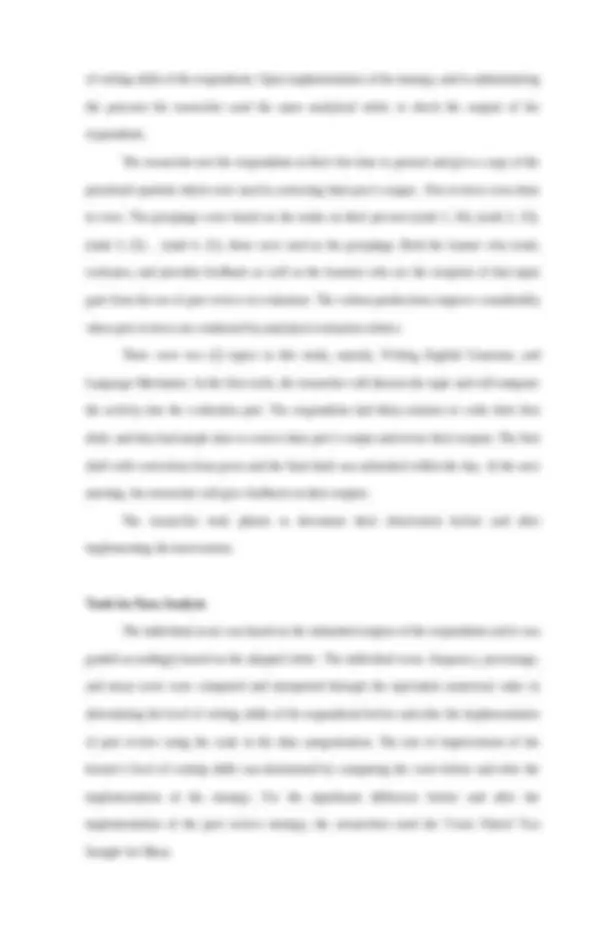
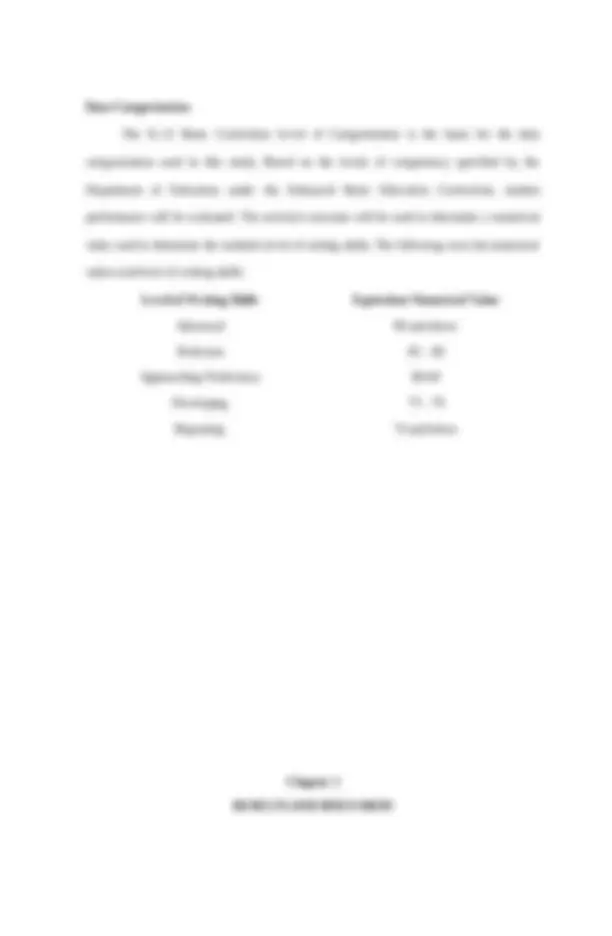
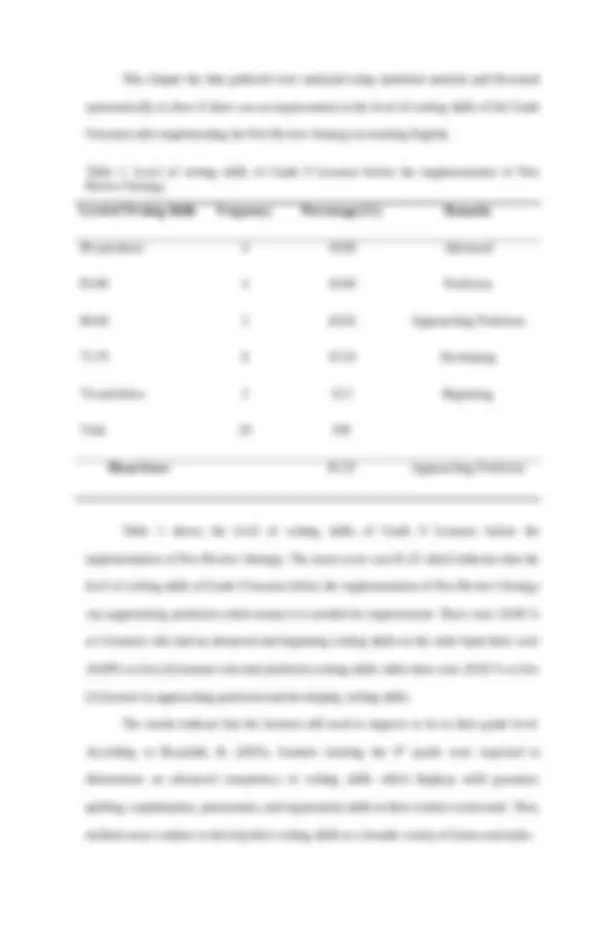
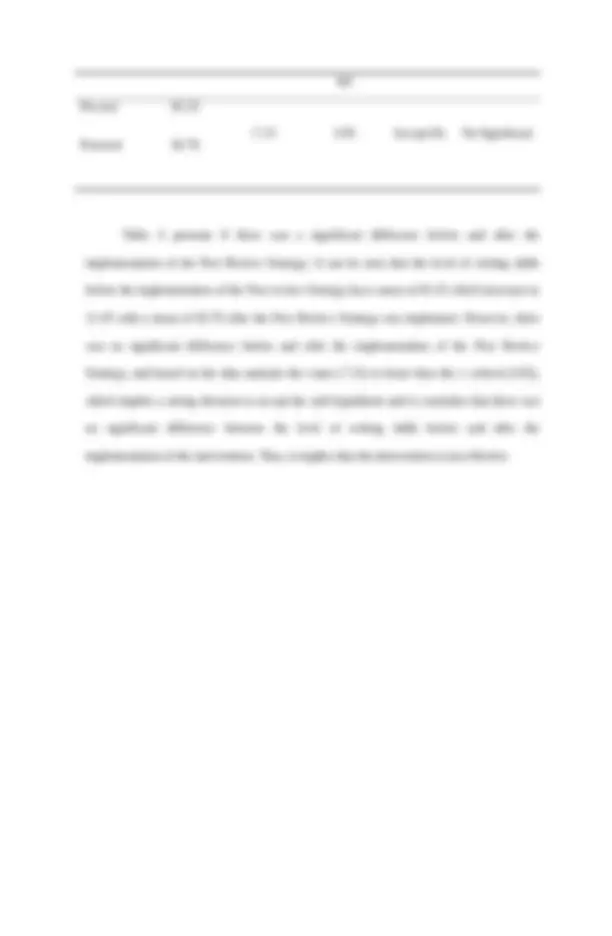
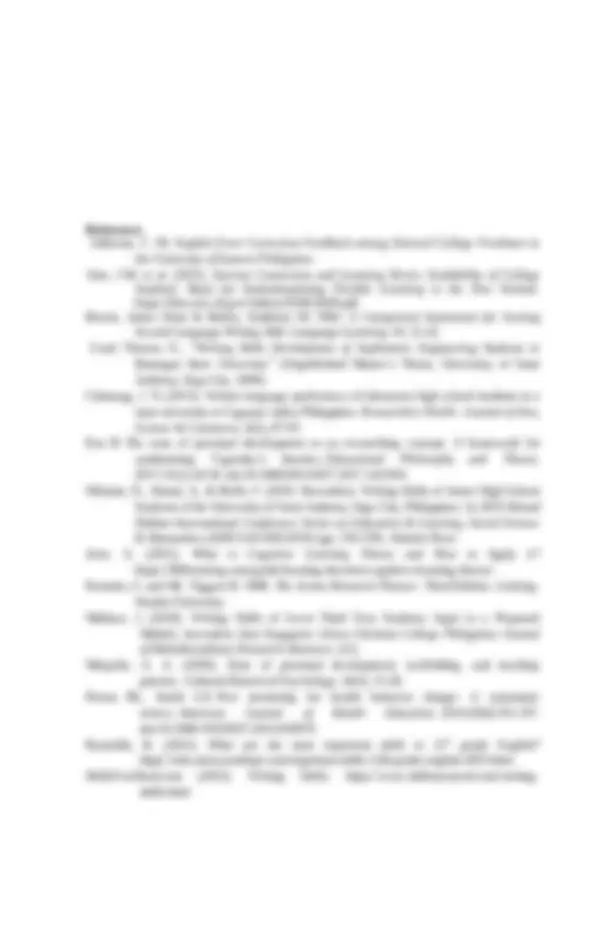
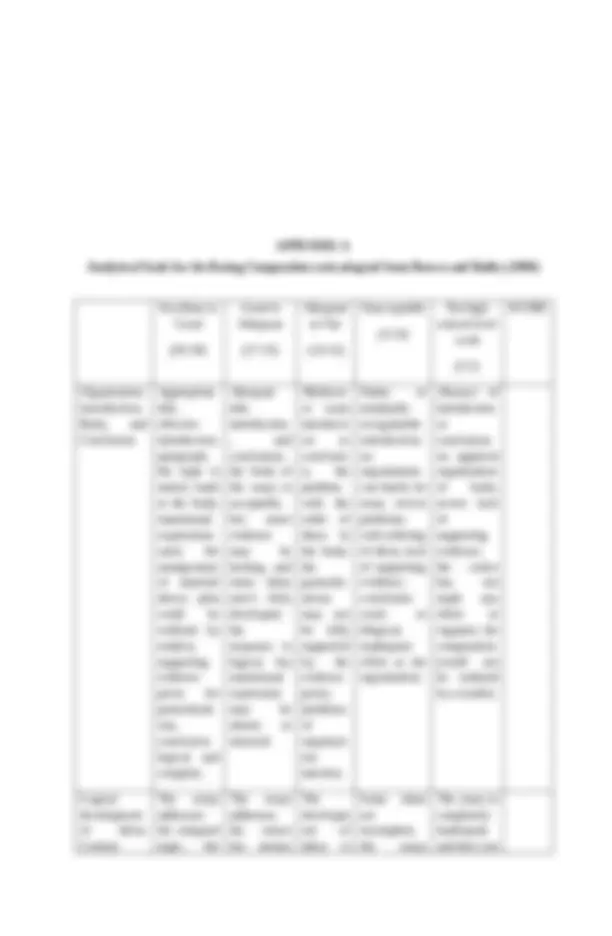
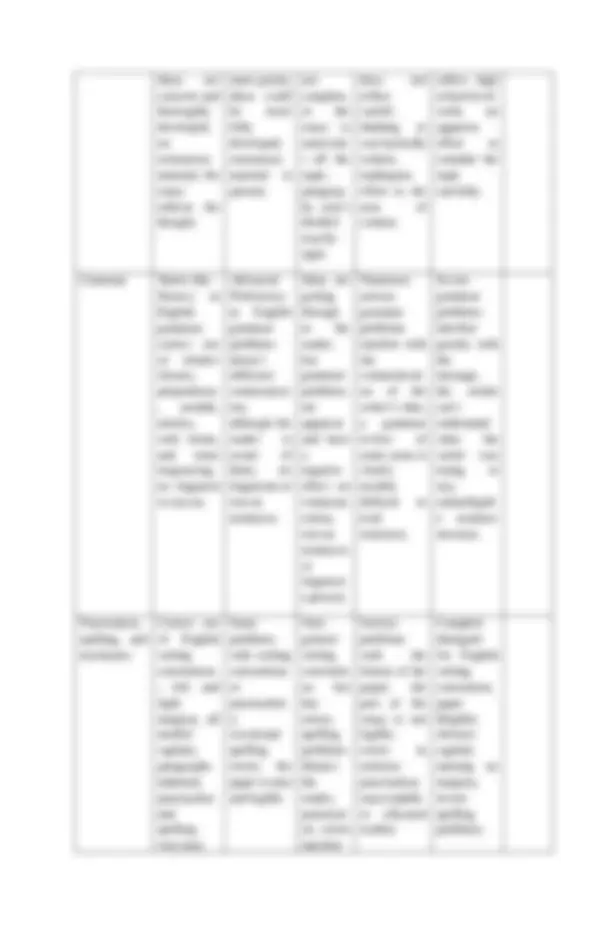
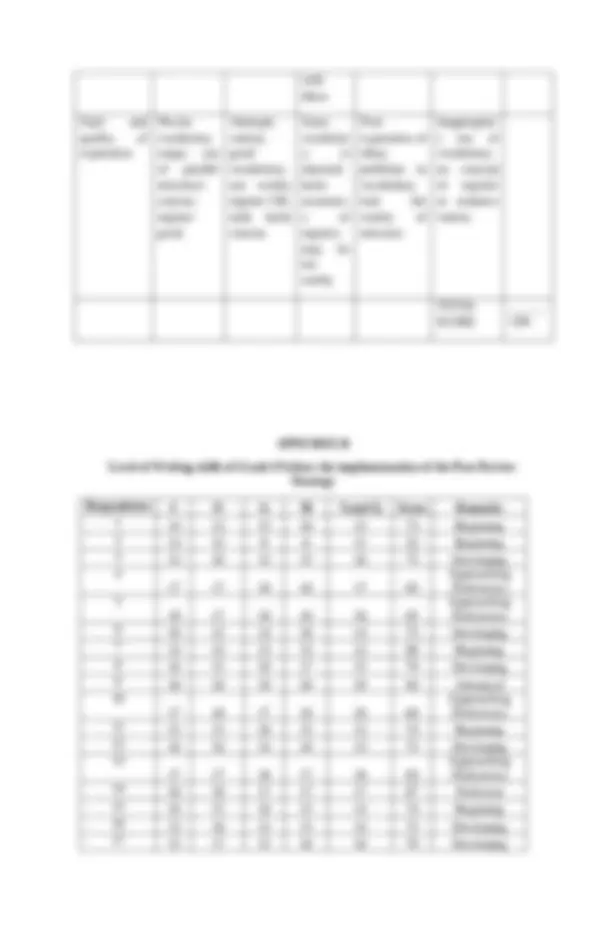

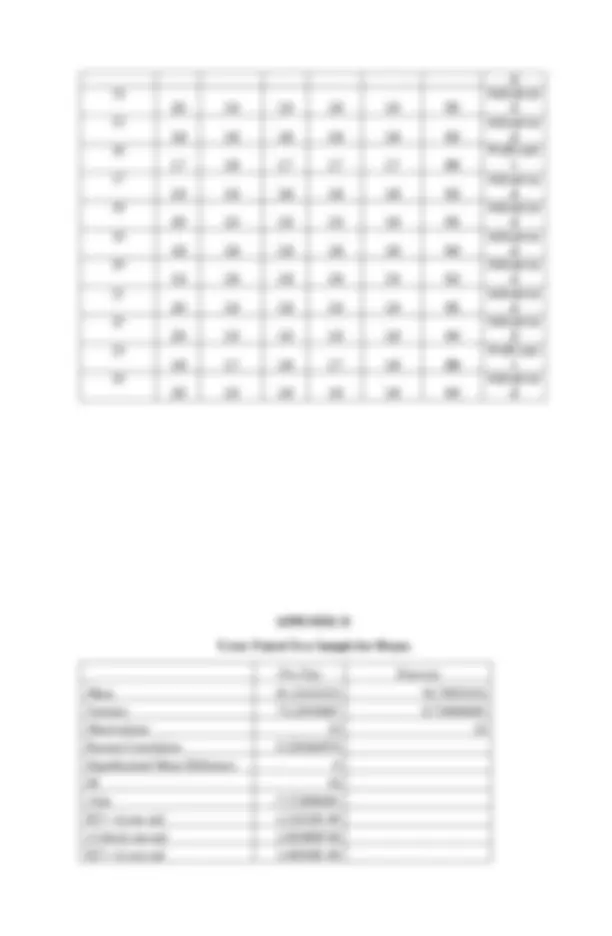



Study with the several resources on Docsity

Earn points by helping other students or get them with a premium plan


Prepare for your exams
Study with the several resources on Docsity

Earn points to download
Earn points by helping other students or get them with a premium plan
Community
Ask the community for help and clear up your study doubts
Discover the best universities in your country according to Docsity users
Free resources
Download our free guides on studying techniques, anxiety management strategies, and thesis advice from Docsity tutors
This is to deal the problem of a learner by using Peer Review strategy to enhance their writing skills.
Typology: Thesis
1 / 25

This page cannot be seen from the preview
Don't miss anything!


















Major in English 2022
Chapter 1 INTRODUCTION Context and Rationale Writing abilities are a crucial component of communication. When compared to speaking to someone directly or over the phone, writing effectively enables you to convey your message to a far bigger audience. Thus, an individual needs the necessary competency for effective writing to come up with an acceptable output. The basics of writing are adherence to the ‘writing mechanics’, including writing form, spelling, punctuation, and writing conventions. The said basics of writing will serve as an important foundation for learners in effective written communication. Communication abilities include writing, which is crucial. When one writes well, they can convey their ideas to a far bigger audience than they could in a face-to-face encounter. Poor writing can leave a bad impression. According to the study of Akmal et al. (2019), writing is a construction process, making it one of the most difficult abilities for kids to learn. Writing activities are entirely distinct from listening, speaking, and reading activities because writing is one of the productive abilities in language learning. Some linguistic conventions must be followed when writing to effectively express ideas and promote self-actualization to readers. Grammar and vocabulary are two of these language components that are covered in writing exercises. This means that writing can give learners a good opportunity to deepen their understanding of grammar. Writing is the process of putting down the visual representations of a language so that the reader can understand the knowledge that the writer has attempted to convey. As Merriwether says, “Writing is a process which involves several identifiable steps”. One of the four LSRW (listening, speaking, reading, and writing) skills in language acquisition is writing. It is a system of written symbols that represent the syllables, words, and sounds of language using a variety of methods, including capitalization, spelling, punctuation, and word shape and function. According to Nunan (2017), “Writing is an extremely complex cognitive activity in which the writer is required to demonstrate control of variables simultaneously. At the sentence level, these include control of contents, format, sentence
contrasting ideas in the passage as well as the right adverb, article, subject-verb agreement, and use of inverted sentences. In the study of Milanao (2018), the common errors in their written composition and the factors affecting the writing skills of the students were also identified. It was found that the most common committed errors of students in their composition in terms of mechanics are the use of punctuation and capitalization; word choice in the structure; and subject-verb agreement and tenses in terms of grammar. Writing composition exercises assist learners to develop and direct their writing abilities, according to Lagayan (2018). Writing a composition comprises the expression of one's emotions as well as essay writing, subject analysis, and response to a certain topic. At some point, the teacher allows students to write in free form to completely express their ideas. On the other hand, a lack of vocabulary and ambiguous sentences make it difficult for learners to acquire basic grammar rules in English. Apart from grammar errors, Umpa et al. (2019) describe mechanics in writing as standards of paragraphing, punctuation, spelling, capitalization, and handwriting as all factors that affect the text's grammatical and aesthetic value. Totto, M., and Ramos, B., (2021) found that mechanics errors are another common mistake made by most learners. During the observation week, the researchers observed that there were learners who commit mistakes in terms of mechanics in the use of punctuation, capitalization, indention, spelling, and word choice in structure. As a result, the researchers came up with an idea to propose another way of enhancing the writing skills of learners through peer review. The researchers conducted the study to enhance the writing skills of Grade 9 learners of the Laboratory High School Department at Don Mariano Marcos Memorial State University-North La Union Campus. The study also sought to bridge the gap between Grade 9 in their writing performance. For this reason, the researchers implemented the proposed strategy to improve the quality of writing skills of the learners as well as the teaching and learning process. Innovation, Intervention, and Strategy
The researchers proposed peer review as an intervention and strategy that equipped the Grade 9 learners of Don Mariano Marcos Memorial State University-North La Union Campus specifically in the Laboratory High School Department in enhancing their writing skills. Writing is a crucial component of language. It requires the writer to display simultaneous control over multiple factors, making it an exceedingly challenging cognitive endeavor. Students' chances of succeeding may be improved by strong writing abilities. All people need to be proficient writers to achieve their educational and employment requirements as students. Good writers are always successful in communicating their ideas and achieving their objectives; thus, this goes without saying to the learners. For there are various advantages and success in life, they should learn how to write. Students learn to write coherently, correctly use grammar structures and spell properly through the writing process. Students' classroom experiences are enhanced by peer review. This study was conducted over a total of 11 weeks, including determining the problem situation (5 weeks), administering the pre-test and post-test (2 weeks), and application of the action plans (4 weeks). The implementation of the peer review strategy was to enhance the writing skills of the learners through integration during the evaluation part wherein the learners will have their activity after the class discussion. The peer reviews were implemented by the pair to give feedback on their first draft before submitting their final outputs. Peer review, according to Toppings (2009), is a formative assessment strategy that enables students to assess the work of their peers in terms of performance and written output, which enhances the caliber of the final product. In fact, this approach results in a deeper comprehension and broader perspective of the subject, which ensures more meaningful learning and higher- quality outputs. Both the student who reads, evaluates, and provides feedback as well as the student who is the recipient of that input gain from the use of peer review in evaluation. Writing exercises from the pre-and post-tests were used as research instruments, and the results were analyzed using a scale to categorize the data. To measure the level of the writing proficiency of the students before and after the adoption of the strategy, the researcher compiled the results of the pre-and post-test using the Analytical Scale for the Rating Composition task adapted from Brown and Bailey (1984). Furthermore, the K–12 Basic
Gather the level of writing skills of the learners before and after the implementation of the strategy. To determine the level of writing skills of the learners. Collect the results of the pre-test and post-test using the adapted Analytical Scale for the Rating Composition task adapted from Brown and Bailey (1984). Researchers October 21, 2022, and November 18, 2022 Analyzed the results To identify if there is a significant difference before and after the implementation of a peer review strategy. Compute and analyze the results. Researchers Statisticians December 1- 9, 2022 Theoretical Framework Vygotsky (1978) is the author who made significant contributions to the social constructivism approach. According to this approach, individuals build their knowledge at a social level and subsequently appropriate it individually. Social interaction serves to awaken cognitive processes and affects both cognitive and language development. The primary focus of Vygotsky's social development theory is on how social contact affects the development process. A collaborative tool that fits into Vygotsky's social-constructivist model is peer review. Peer review, according to Falchicov (1995), is a procedure in which people are assessed by their peers. Using rubrics that have already been developed by others—possibly by the teachers—or that have even been improved by the group in response to their needs, may speed up the process. Socialization among their peers will give them more chances to explore and unravel their abilities as they will give feedback to enhance their writing skills. The social learning theory of Vygotsky strongly supports that the use of zone proximal development will enhance the writing skills of Grade 9 learners. The zone of proximal development (ZPD), also known as the zone of potential development, is the set of skills that a person can execute under the direction of a professional but cannot yet perform alone. According to Cherry (2021), this learning theory, which was created by psychologist Lev
Vygotsky, can be seen in a classroom or anywhere else where a person has the chance to learn new abilities. In the study of Eun, B. (2017), there are several core concepts developed by Vygotsky and expanded upon by others following him that have helped round out this learning theory. The success of this learning process involves: (1) the presence of someone with the knowledge and skills to guide the learner, (2) supportive activities, known as scaffolding, provided by the expert that help guide the learner, and (3) social interactions that allow the learner to work on their skills and abilities. Furthermore, Vygotsky thought that social interaction between a student and someone with more experience was essential for learning to occur. Vygotsky highlighted the importance of peer learning while acknowledging that the expert may be an adult. In the study of Peter (2012), the researcher gave an instance of a social engagement between the adult expert and all of the children that is initially vital while youngsters are learning a new topic. But peer interaction might produce the best learning environment if some learners understand the concept while others are still in their ZPD. Cognitive development is the process by which we come to acquire, understand, organize, and learn to use information in various ways proposed by Jean Piaget. According to Jarre (2021), Cognitive Learning Theory makes use of metacognition, or "thinking about thinking," to analyze how the mind affects learning. It frequently contrasts with or complements behavioral learning theory, which emphasizes how the environment outside the classroom affects learning. The Grade 9 learners improved more in their writing skills through intellectual sharing of what they know by helping their peers over correcting their written outputs which will further broaden their knowledge and have a deep understanding of their compositions.
Consequently, the process consists of pre-test and post-test on the writing skills of the learners who commit mistakes in terms of mechanics the use of punctuation, capitalization, indention, spelling, and word choice in structure using the adapted Analytical Scale for the Rating Composition task adapted from Brown and Bailey (1984). The researchers implemented a certain strategy to enhance the writing skills of Grade 9 learners which is the peer review strategy. The strategy used came from the idea that the learners can read over their peers' work and prepare comments for output improvement. The researchers' conviction that learning occurs more effectively in a collaborative setting serves as the foundation for this idea. There were different tools and instruments for interpreting and analyzing data. The anticipated output or the results of the study was the enhanced writing skills of Grade 9 learners after the implementation of the said intervention which is the peer review. Research Questions This study aimed to enhance the writing skills of Grade 9 learners at the Laboratory High School Department of Don Mariano Marcos Memorial State University-North La Union Campus. Specifically, it sought to answer the following questions:
Analytical Scale for the Rating Composition Task - it is a rubric adapted from Brown and Bailey (1984) to determine the level of writing skills of the learners before and after the implementation of the strategy Content - logical development of the respondent’s ideas Grade 9 learners - they are the respondents of the study Grammar- fluency in using sentence structure to convey the respondent’s idea Level of writing skills - use to determine the respondent’s achievement through their individual score before and after the implementation of peer review. Mechanics- correct use of English writing conventions such as in punctuation, and spelling Organization- the way of writing skills of the respondents in conveying ideas is organized and logical Peer Review - the proposed strategy to enhance the writing skills of Grade 9 Writing skills- is a skill of the learners that need to be improved. Chapter 2 METHODOLOGY Research Design The researcher used descriptive quantitative, and developmental research. Primary data was collected by the researchers. According to QuestionPro (2022), descriptive research
of writing skills of the respondents. Upon implementation of the strategy, and in administering the post-test the researcher used the same analytical rubric to check the outputs of the respondents. The researcher met the respondents in their free time to present and give a copy of the proofread symbols which were used in correcting their peer’s output. Peer reviews were done in twos. The groupings were based on the ranks on their pre-test (rank 1, 24), (rank 2, 23), (rank 3, 22)… (rank 4, 21), these were used as the groupings. Both the learner who reads, evaluates, and provides feedback as well as the learners who are the recipient of that input gain from the use of peer review in evaluation. The written productions improve considerably when peer reviews are conducted by analytical evaluation rubrics. There were two (2) topics in this study, namely, Writing English Grammar, and Language Mechanics. In the first week, the researcher will discuss the topic and will integrate the activity into the evaluation part. The respondents had thirty minutes to write their first draft, and they had ample time to correct their peer’s output and revise their outputs. The first draft with corrections from peers and the final draft was submitted within the day. At the next meeting, the researcher will give feedback on their outputs. The researcher took photos to document their observation before and after implementing the intervention. Tools for Data Analysis The individual score was based on the submitted outputs of the respondents and it was graded accordingly based on the adapted rubric. The individual score, frequency, percentage, and mean score were computed and interpreted through the equivalent numerical value in determining the level of writing skills of the respondents before and after the implementation of peer review using the scale in the data categorization. The rate of improvement of the learner’s level of writing skills was determined by comparing the cores before and after the implementation of the strategy. For the significant difference before and after the implementation of the peer review strategy, the researchers used the T-test: Paired Two Sample for Mean.
Data Categorization The K–12 Basic Curriculum Level of Categorization is the basis for the data categorization used in this study. Based on the levels of competency specified by the Department of Education under the Enhanced Basic Education Curriculum, student performance will be evaluated. The activity's outcome will be used to determine a numerical value used to determine the student's level of writing skills. The following were the numerical values and level of writing skills: Level of Writing Skills Equivalent Numerical Value Advanced Proficient Approaching Proficiency Developing Beginning 90 and above 85 – 89 80- 75 – 79 74 and below Chapter 3 RESULTS AND DISCUSSION
Table 2. Level of writing skills of Grade 9 Learners after the implementation of Peer Review Strategy Level of Writing Skills Frequency Percentage (%) Remarks 90 and above 20 83.33 Advanced 85-89 4 16.66 Proficient 80-84 - - - 75-79 - - - 74 and below - - - Total 24 100 Mean Score 93 Advanced Table 2 presents the level of writing skills of Grade 9 Learners after the implementation of the Peer Review Strategy. The mean score was 93 which indicates that the level of writing skills of Grade 9 learners after the implementation of the Peer Review Strategy was improved to an advanced level of writing skills. Though there were 16.66 % or four (4) learners with proficient writing skills. While on the other hand 83.33 % or twenty (20) learners who had an advanced writing skill. Hence, many students find it difficult to let go of their original ideas, even though revision is just as important to the writing process as the first draft. By keeping their audience in mind and participating in focused peer review exchanges, students can give insightful feedback, receive insightful criticism, and master revision. Real literacy develops among a group of people who can connect in meaningful ways. The form of social engagement and collaboration is made possible by peer review Baker (2016).
Table 3. Learners with improved writing skills after the implementation of Peer Review Strategy No. of Learners Frequency Percentage (%) With improvement 24 100 With no improvement - - Total 24 100 Table 3 displays the number of learners with improved writing skills after the implementation of the Peer Review Strategy. One hundred percent or twenty-four (24) learners improved in their writing skills. Hence, the intervention helps to elevate the writing skills of the students, specifically, the students find it difficult to let go of their original ideas, even though revision is just as important to the writing process as the first draft. By keeping their audience in mind and participating in focused peer review exchanges, students can give insightful feedback, receive insightful criticism, and master revision. Real literacy develops among a group of people who can connect in meaningful ways. The form of social engagement and collaboration is made possible by peer review Baker (2016). Furthermore, it connects to the theory of Lev Vygotsky, that learning takes place in the interaction or most known as the social learning theory of Vygotsky which strongly supports the use of zone proximal development that individuals build their knowledge at a social level and subsequently appropriate it individually. Social interaction serves to awaken cognitive processes and affects both cognitive and language development. Table 4. The significant difference of the writing skills of Grade 9 before and after the implementation of Peer Review Strategy Variables Mean t-stat t Critical two- Decision Remarks
References Adlawan, C. M. English Error Correction Feedback among Selected College Freshmen in the University of Eastern Philippines. Asio, J.M. et al. (2021). Internet Connection and Learning Device Availability of College Students: Basis for Institutionalizing Flexible Learning in the New Normal. https://files.eric.ed.gov/fulltext/ED613639.pdf Brown, James Dean & Bailey, Kathleen M. 1984. A Categorical Instrument for Scoring Second Language Writing Skill, Language Learning , 43, 21-42. Conti Thereza O., “Writing Skills Development of Sophomore Engineering Students in Batangas State University” (Unpublished Master’s Thesis, University of Saint Anthony, Iriga City, 2000). Cabansag, J. N. (2013). Written language proficiency of laboratory high school students in a state university in Cagayan valley Philippines. Researchers World—Journal of Arts, Science & Commerce , 4 (2), 87-93. Eun B. The zone of proximal development as an overarching concept: A framework for synthesizing Vygotsky’s theories. Educational Philosophy and Theory. 2017;51(1):18-30. doi:10.1080/00131857.2017. Hikmah, N., Akmal, A., & Buffe, F. (2019, November). Writing Skills of Junior High School Students of the University of Saint Anthony, Iriga City, Philippines. In 2019 Ahmad Dahlan International Conference Series on Education & Learning, Social Science & Humanities (ADICS-ELSSH 2019) (pp. 156-159). Atlantis Press. Jarre, A. (2021). What is Cognitive Learning Theory and How to Apply it? https://360learning.com/guide/learning-theories/cognitive-learning-theory/ Kemmis, S. and Mc. Taggart R. 1988. The Action Research Planner. Third Edition. Geelong: Deakin University. Malinao, I. (2018). Writing Skills of Lucst Third Year Students: Input to a Proposed Module. Ascendens Asia Singapore–Union Christian College Philippines Journal of Multidisciplinary Research Abstracts , 1 (1). Margolis, A. A. (2020). Zone of proximal development, scaffolding, and teaching practice. Cultural-Historical Psychology , 16 (3), 15-26. Petosa RL, Smith LH. Peer mentoring for health behavior change: A systematic review. American Journal of Health Education. 2014;45(6):351-357. doi:10.1080/19325037.2014. Reynolds, B. (2021). What are the most important skills in 12 th^ grade English? https://education.seattlepi.com/important-skills-12th-grade-english-2655.html. SkillsYouNeed.com (2022). Writing Skills. https://www.skillsyouneed.com/writing- skills.html
Analytical Scale for the Rating Composition task adapted from Brown and Bailey (1984) Excellent to Good (20-18) Good to Adequate (17-15) Adequate to Fair (14-12) Unacceptable (11-6) Not high school-level work (5-1)
Organization: Introduction, Body, and Conclusion Appropriate title, effective introductory paragraph, the topic is stated, leads to the body; transitional expressions used; the arrangement of material shows plan could be outlined by readers; supporting evidence given for generalizati ons; conclusion logical and complete. Adequate title, introduction , and conclusion; the body of the essay is acceptable, but some evidence may be lacking, and some ideas aren’t fully developed; the sequence is logical but transitional expression may be absent or misused. Mediocre or scant introducti on or conclusio n; the problem with the order of ideas in the body; the generaliz ations may not be fully supported by the evidence given; problems of organizat ion interfere. Shaky or minimally recognizable introduction; an organization can barely be soon; severe problems with ordering of ideas; lack of supporting evidence; conclusion weak or illogical; inadequate effort at the organization. Absence of introduction or conclusion; no apparent organization of body; severe lack of supporting evidence; the writer has not made any effort to organize the composition (could not be outlined by a reader). Logical development of ideas: Content The essay addresses the assigned topic; the The essay addresses the issues but misses The developm ent of ideas is Some ideas are incomplete; the essay The essay is completely inadequate and does not